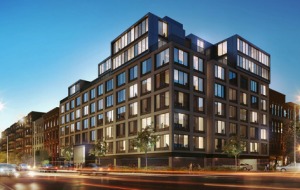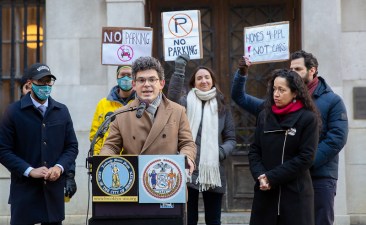Zero Parking Means More Affordable Housing for Fort Greene

Last month, builders broke ground on Fort Greene’s Navy Green project, which, when completed, will add 458 homes between the Navy Yard and the BQE. A full three-quarters of the project will be affordable to families earning between 30 and 130 percent of the area median income, and 97 of those residences will be supportive housing, offering social services in addition to shelter.
Such affordable prices for housing wouldn’t have been possible had Navy Green been subject to the area’s parking requirements. Nor would the 32,000 square feet of open space included in the project. Without an exemption granted by the city, said the project’s developer, parking would have replaced a playground and increased the cost of each unit.
Developer Martin Dunn explained that each parking space came with a direct tradeoff in terms of open space and affordability. “To meet the parking requirements that would normally be required,” he said, “if we made half the open space parking, we’d still have to build structured parking.”
Structured parking is expensive to build. Nationally, the average construction cost of a single structured space is $16,000, and in New York it is almost certainly higher. Building a garage, said Dunn, would have required either increasing rents or asking the government for extra subsidies. “So not having structured parking made it more affordable,” he concluded.
Even if the parking requirements were relaxed for Navy Green, including any parking at all would have taken away the project’s gardens and play spaces. Most affordable housing puts its parking at grade, explained Dunn, because that’s the cheapest option. With only so many square feet to go around, “there is a direct tradeoff between open space and parking.”
The city government concurred with Dunn’s assessment. A spokeswoman for the Department of Housing Preservation and Development said that including parking was financially infeasible on the site, considering the needs for affordability and open space. HPD, therefore, applied for a mayoral override of the parking requirement, which was granted. “The city agencies were all very supportive,” Dunn recalled.
Though the project will be entirely without off-street parking, it will include bike storage in all of the multi-family buildings. The new Flushing Avenue bike lane travels right by the project site, as do a number of bus routes. The first building is scheduled to open in December 2011.
In earlier affordable projects, Dunn said that he hadn’t taken the same zero-parking approach. At the nearby Myrtle Avenue Apartments, for example, zoning required that they build parking for 25 percent of the units, leading to eight spaces. At the price of $25 per month, there have never been more than two spaces rented, said Dunn. The company could have built a bigger playground instead of those empty parking spots. “We’ve felt bad that we built that parking every day since,” he said.

